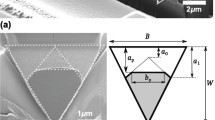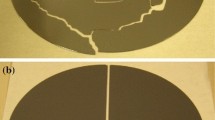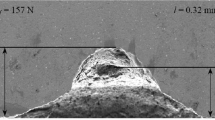Abstract
Fracture interfaces formed in silicon nitride at high temperatures were studied using light and electron microscopy. The structure of the fracture interface depended on the type of silicon nitride fractured. High-purity, reaction-bonded silicon nitride always formed flat, relatively featureless, fracture surfaces. Fracture occurred by a brittle mode even at the highest temperature (1500° C) studied. The critical stress intensity factor for reaction-bonded silicon nitride (∼ 2.2 MN m−3/2) is relatively low and is insensitive to temperature. By contrast, hot-pressed silicon nitride gave evidence of plastic flow during fracture at elevated temperatures. Crack growth in magnesia-doped, hot-pressed silicon nitride occurs by creep, caused by grain boundary sliding and grain separation in the vicinity of the crack tip. As a consequence of this behaviour, extensive crack branching was observed along the fracture path. The primary and secondary cracks followed intergranular paths; sometimes dislocation networks, generated by momentary crack arrest, were found in grains bordering the crack interface. As a result of the high temperature, cracks were usually filled with both amorphous and crystalline oxides that formed during the fracture studies. Electron microscopy studies of the compressive surfaces of fourpoint bend specimens gave evidence of grain deformation at high temperatures by diffusion and dislocation motion.
Similar content being viewed by others
References
A. G. Evans andR. W. Davidge,J. Mater. Sci. 5 (1970) 314.
W. Ashcroft, “Ceramics for Turbines and Other High-Temperature Engineering Applications”, (British Ceramic Society, Stoke-on-Trent, 1973). p. 169.
M. L. Torti, R. A. Alliegro, D. W. Richerson, M. E. Washburn andG. Q. Weaver,ibid“. p. 129.
A. G. Evans andS. M. Wiederhorn,J. Mater. Sci. 9 (1974) 270.
F. F. Lange,J. Amer. Ceram. Soc. 57 (1974) 84.
R. Kossowsky, D. G. Miller, andE. S. Diaz,J. Mater. Sci. 10 (1975) 983.
A. G. Evans, “Ceramics for High-Performance Applications”, edited by J. J. Burke, A. E. Gorum and R. N. Katz (Brook Hill, Mass., 1974) p. 373.
P. Drew andM. H. Lewis,J. Mater. Sci. 9 (1974) 261.
N. J. Tighe, “Nitrogen Ceramics,” edited by F. Riley (Noordhoff, Leyden, 1977) p. 441.
A. G. Evans andJ. V. Sharp,J. Mater. Sci. 6 (1971) 1292.
N. J. Tighe, Proceedings of the Electron Microscopy Society of America, Vol. 32 (Claitors Publishing Co.. Baton Rouge, La., 1974) p. 470.
Idem, “Electron Microscopy in Mineralogy”, edited by H. -R. Wenk (Springer-Verlag, Berlin, 1976) p. 144.
R. Kossowsky,J. Mater. Sci. 8 (1973) 1603.
D. R. Clarke andG. Thomas,J. Amer. Ceram. Soc. 60 (1977) 491.
Author information
Authors and Affiliations
Rights and permissions
About this article
Cite this article
Tighe, N.J. The structure of slow crack interfaces in silicon nitride. J Mater Sci 13, 1455–1463 (1978). https://doi.org/10.1007/BF00553199
Received:
Accepted:
Issue Date:
DOI: https://doi.org/10.1007/BF00553199




